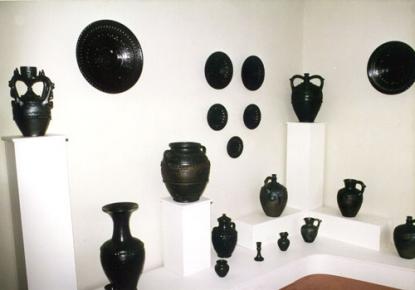2024. December 21. Saturday
Kossuth Cinema Gallery - Mohács
 |
Address: 7700, Mohács Deák tér 3.
Phone number: (69) 311-031, (69) 510-477
E-mail: mohacsmozi@gmail.com
Opening hours: Mon-Sat 10-16
|
Museum tickets, service costs:
|
Ticket for adults
|
300 HUF
|
|
|
Ticket for students
(over 14 years of age)
|
200 HUF
|
|
|
Ticket for children
(under 14 years of age)
|
100 HUF
|
|
|
Ticket for pensioners
|
200 HUF
|
The popular pottery of Mohács had first of all become famous within Hungary because of its special black ceramics.

During the 18-19th centuries black pot-makers had worked here together with the local potters, oven-makers and argillaceous smoking pipe makers. In 1718 they formed a guild organisation together, but from 1803 the black pot-makers were working in their independent guild.
Hundreds of their glazeless black tobies, mortars, aqua- and pastry holders were shipped over the Danube to the local and Balcanian markets.
The conventional Mohácsian black ceramics kept a number of archaik, Turkish and Balcanian features. The Surface ornamentation was most of the times carried out by scratching or "scrubbing" as it were. The black colour of the pots were gained by the closing off the air in the oven (reduction). This technology is still kept up today.
One of the descendants of the dinasty, János Horváth proved to be a prominent master (1905-1975) who tought several youngsters for the secrets of the craft.
In Mohácson and its vicinity black ceramics are still made today. The inheritance was further enriched by several young masters, such as József Ginter, Ferenc Kovácsics, Ákos Molnár, József Molnár, László Reininger, Béla Simonkovits, Mrs. Ujváry-Menyhárt.

During the 18-19th centuries black pot-makers had worked here together with the local potters, oven-makers and argillaceous smoking pipe makers. In 1718 they formed a guild organisation together, but from 1803 the black pot-makers were working in their independent guild.
Hundreds of their glazeless black tobies, mortars, aqua- and pastry holders were shipped over the Danube to the local and Balcanian markets.
The conventional Mohácsian black ceramics kept a number of archaik, Turkish and Balcanian features. The Surface ornamentation was most of the times carried out by scratching or "scrubbing" as it were. The black colour of the pots were gained by the closing off the air in the oven (reduction). This technology is still kept up today.
One of the descendants of the dinasty, János Horváth proved to be a prominent master (1905-1975) who tought several youngsters for the secrets of the craft.
In Mohácson and its vicinity black ceramics are still made today. The inheritance was further enriched by several young masters, such as József Ginter, Ferenc Kovácsics, Ákos Molnár, József Molnár, László Reininger, Béla Simonkovits, Mrs. Ujváry-Menyhárt.
